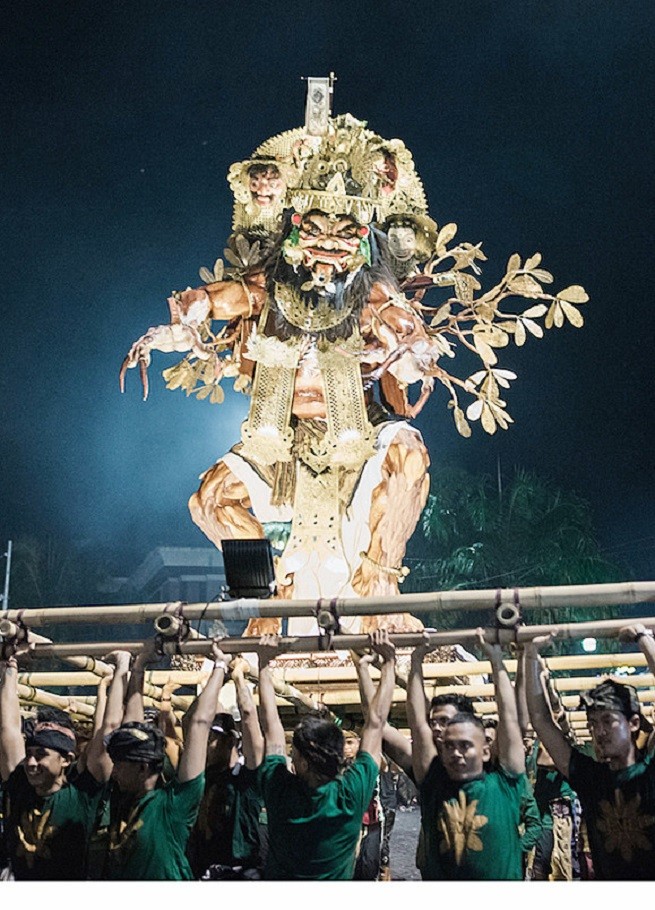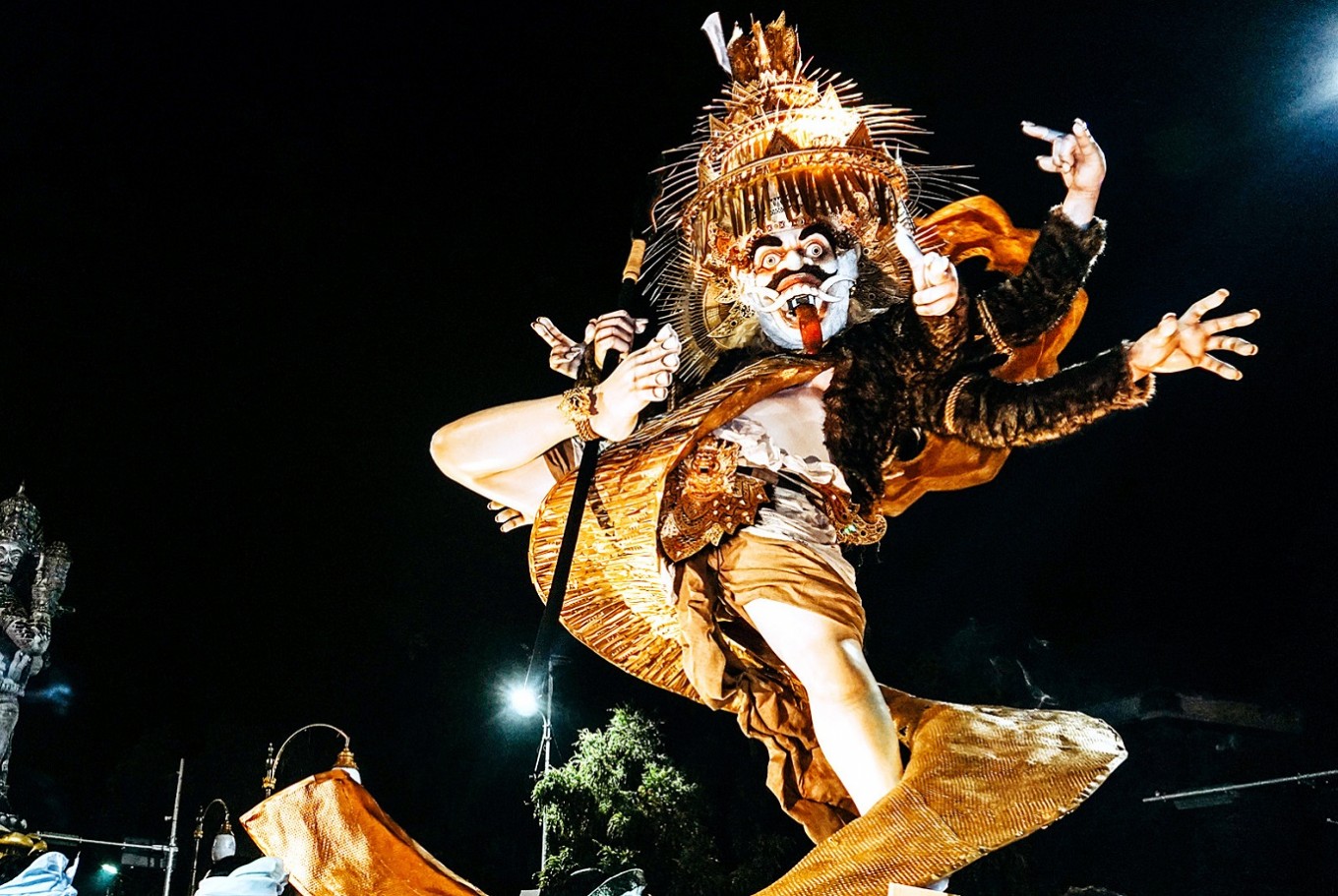Popular Reads
Top Results
Can't find what you're looking for?
View all search resultsPopular Reads
Top Results
Can't find what you're looking for?
View all search resultsBali's biggest street party
The Ngerupuk street parade is a good reason to take a short leave and visit Denpasar.
Change text size
Gift Premium Articles
to Anyone
N
gerupuk, a street parade held on the eve of Balinese Hinduism’s Day of Silence, is without a doubt the biggest and loudest street party on the island, drawing the attention of both locals and tourists, some of whom plan their visit around the annual event.
The centerpieces of the parade are the ogoh-ogoh, menacing-looking gigantic statues. Some are built in the form of a terrifying demon, while others are inspired by the wrathful manifestation of Hindu deities.
There is also a growing trend among local youths of looking for inspiration outside Hindu lore. The appearance of a green dinosaur and red Ultraman in Denpasar as well as King Kong in Tegalalang, Gianyar, during this year’s Ngerupuk last week was a testament to that trend.
Read also: The evolution of 'ogoh-ogoh'
With each ogoh-ogoh accompanied by approximately 100 youths, who carried their statues on bamboo platforms alongside gamelan ensembles, an estimated 700,000 youths marched the island’s streets that night.
Taking into account the number of spectators, at least 1 million people crowded the streets during this year’s Ngerupuk. It was no wonder then that traffic, particularly in the greater Denpasar area, which includes Sanur and Kuta, was brought to a standstill for hours during the parade.
 Go green: Taru Pule, ogoh-ogoh crafted by youths of Gemeh, is made from eco-friendly material.(STT Gemeh Indah/File)
Go green: Taru Pule, ogoh-ogoh crafted by youths of Gemeh, is made from eco-friendly material.(STT Gemeh Indah/File)
Ogoh-ogoh started becoming a staple of the parade in the early 1980s. Prior to that, Ngerupuk’s participants roamed the streets carrying bamboo torches and making loud noises with percussion instruments to scare away the demons.
However, a smaller version of the ogoh-ogoh — carried at the front of the parade for large-scale Ngaben cremation ceremonies — had existed long before the 1980s. Historical footage shot by famed Canadian composer Colin McPhee at a royal cremation in Gianyar in 1933 show several small ogoh-ogoh during the procession.
In present-day Bali, the majority of ogoh-ogoh are built by members of seka teruna teruni, the youth wing of banjar (traditional subvillage). A banjar is the core unit of Balinese traditional society and its members are obliged to assist each other during time-consuming and labor-intensive Balinese Hinduism rituals. Each banjar is usually made of 50 to 100 households.
To these youths, ogoh-ogoh is more than just an opportunity to showcase their creations at a parade. It is also a rite of passage, through which they establish and foster camaraderie with their peers of the same banjar.
Constructing ogoh-ogoh usually takes one month and during that period, they spend hours in the evening together crafting the statue by weaving bamboo strips, gluing paper and carving and painting the statues.
 Go green: Taru Pule, ogoh-ogoh crafted by youths of Gemeh, is made from eco-friendly material.(STT Gemeh Indah/File)
Go green: Taru Pule, ogoh-ogoh crafted by youths of Gemeh, is made from eco-friendly material.(STT Gemeh Indah/File)
Throughout the process they learn the labor and social skills necessary for their future role as adult members of the banjar.
At the end of each laborious evening session they dine and drink together, an intimate gathering punctuated by social bonding in the form of bantering, which solidifies their relationship as a single social unit.
Read also: Four adventures to seek in Indonesia in April
This year the bantering expanded to Instagram, as local youths taunted their peers with hashtags #nuingetjalankebanjar (still know the direction to the banjar) and #maikebanjar (come to the banjar). The hashtags accompanied photographs of a nearly empty banjar hall with only a few youths working on the ogoh-ogoh.
The feeds, posted by youths from various banjar across Denpasar and Badung, immediately spurned hilarious posts in response, from a group of youths posing with a placard that read “[you] don’t have to go to the banjar, the ogoh-ogoh is already finished,” to a young kitchen worker with a placard that read “sorry bros, [I am] still working, [I] will buy you all palm toddy later on.” Another post included a group of girls making duck faces while holding a placard that read “come here guys, the girls are already in the banjar to cheer you all on while you make ogoh-ogoh.”
The island’s biggest street party, therefore, is a lot more than just a captivating spectacle. It also reflects the ongoing dedication of the local youths to two of the most important pillars of Balinese culture: its ritualistic art and traditional institution.











